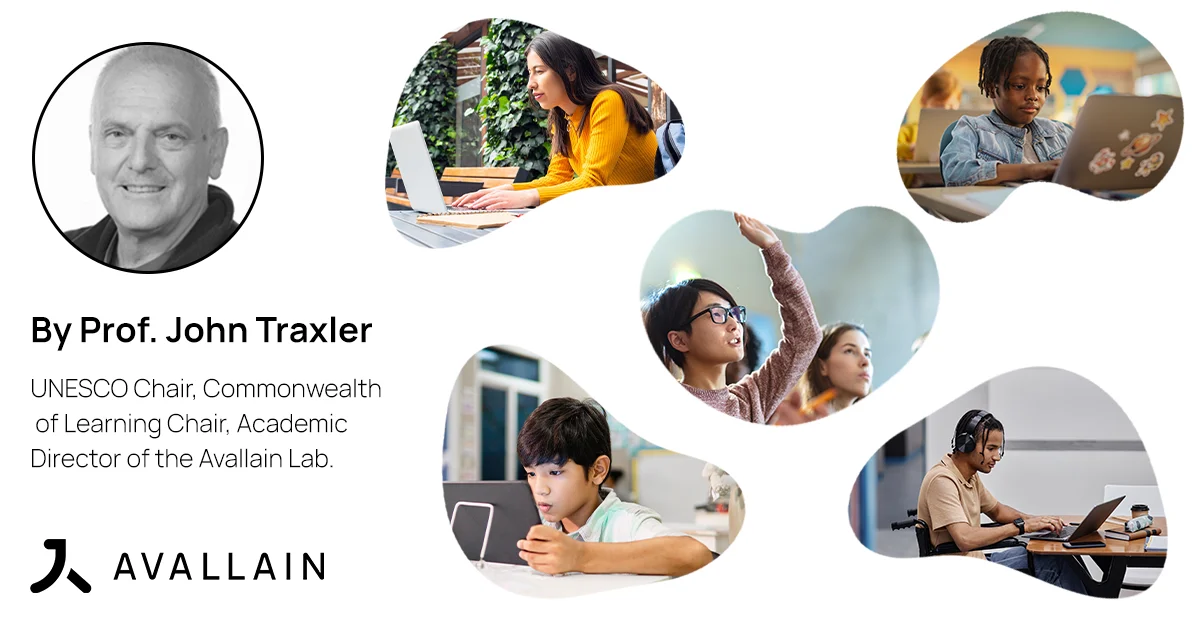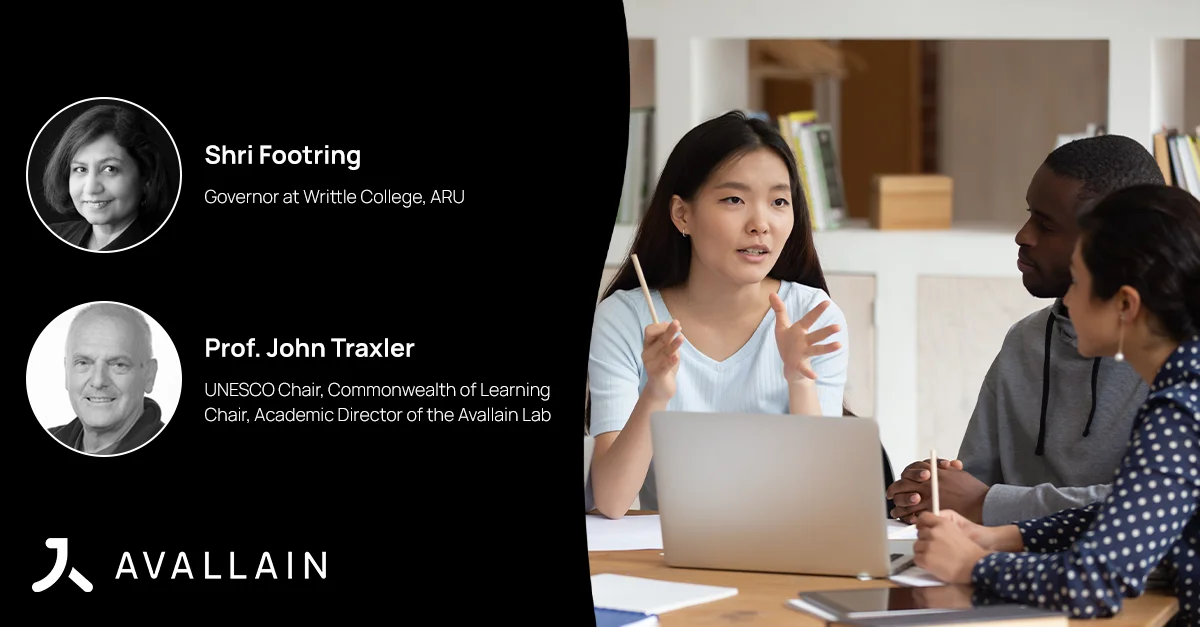
7 min read
2025/04/25
True inclusivity in digital education demands more than good intentions. Colonial legacies still influence the technologies and systems we use today. As we embrace AI, we must consider whether it truly serves all learners or if it carries the biases of the past along with the impact of digital neo-colonialism in education. Drawing on work commissioned by UNESCO and discussions across UK universities, this is an opportunity to recognise hidden influences and ultimately create a fairer and more equitable digital learning environment.
How Can We Navigate the Path to Truly Inclusive Digital Education?
Author: John Traxler, UNESCO Chair, Commonwealth of Learning Chair and Academic Director of the Avallain Lab
What Are We Talking About?
St. Galen, April 25, 2025 – This blog draws on work commissioned by UNESCO, to be published later in the year1, and on webinars across UK universities. Discussions about decolonising educational technology have formed part of initiatives in universities globally, alongside those about decolonising the curriculum, as part of the ‘inclusion, diversity and equity’ agenda, and in the wider world, alongside movements for reparations2 and repatriation3.
This blog was written from an English perspective. Other authors would write it differently.
Decolonising is a misleadingly negative-sounding term. The point of ‘decolonising’ is often misunderstood to be merely remediation, undoing the historical wrongs to specific communities and cultures and then making amends. Yes, it is those things, but it is also about enriching the educational experience of all learners, helping them understand and appreciate the richness and diversity of the world around them.
Colonialism is not limited to the historical activities of British imperialists or even European ones. Tsarist Russia, Soviet Russia, Imperial China, Communist China and Ottoman Turkey are all examples. It remains evident within the one-time coloniser nations and the one-time colonised; Punjabi communities in the English West Midlands and Punjab itself, both still living with the active legacies of an imperial past. It is present in legacy ex-colonial education systems, in the ‘soft power’ of the Alliance Française, the Voice of America, the Goethe Institute, the British Council, the Instituto Cervantes, the World Service, the Peace Corps and the Confucius Institutes, and is now resurgent as the digital neo-colonialism of global corporations headquartered in Silicon Valley.
Why does it matter? It matters because it is an issue of justice and fairness, of right and wrong, and it matters to policy-makers, teachers, learners, employers, companies and the general public as a visible and emotive issue.
What About Educational Technology?
How is it relevant to educational technology? Firstly, ‘educational technology’ is only the tip of the iceberg in terms of how people learn with digital technology. People learn casually, opportunistically and unsupported, driven by momentary curiosity, self-improvement and economic necessity. They do so outside systems of formal instruction. Decolonising ‘educational technology’ may be easier and more specific than decolonising the digital technologies of informal learning, but they have many technologies in common.
At the most superficial level, the interactions and interfaces of digital technologies are dominated by images that betray their origins through visual metaphors such as egg-timers, desktops, files, folders, analogue clocks, wastepaper bins, gestures like the ‘thumbs up’ and cultural assumptions such as green meaning ‘go’. These technologies often default to systems and conventions shaped by history, such as the Gregorian calendar, the International Dateline, Mercator projections, Imperial weights and measures (or Système Internationale) and naming conventions like Far East, West Indies and Latin America. They also tend to prioritise the colonial legacies, European character sets, American spelling and left-to-right, top-to-bottom typing.
Speech recognition still favours the global power languages and their received pronunciation, vocabulary and grammar. Other languages and dialects only come on stream slowly; likewise, language translation. Furthermore, the world’s digital content is strongly biased in favour of these powerful languages, values and interests. Consider Wikipedia, for example, where content in English outweighs that in Arabic by about ten-to-one, and content on Middle-earth outweighs that on most of Africa. Search engines are common tools for every kind of learner, but again, the research literature highlights the bias in favour of specific languages, cultures and ideas. Neologisms from (American) English, especially for new products and technologies, are often absorbed into other languages without change.
On mobiles, the origins of textspeak from corporations targeting global markets, technically using ASCII (American Standard Code for Information Interchange), meant different language communities were forced to adapt. For example, using pinyin letters rather than Chinese characters or inventing Arabish to represent the shape of Arabic words using Latin characters.
In reference to educational technology, we have to ask about the extent to which these embody and reinforce, specifically European, ideas about teaching, learning, studying, progress, assessment, cheating, courses and even learning analytics and library usage. Additionally, if you look at the educational theories that underpin educational technologies and then the theorists who produced them, you see only white male European faces.
The Intersection of Technology and Subjects
There is, however, the extra complication of the intersection of what we use for teaching, the technology, and what gets taught from the different topics to subjects. The subjects are also being subjected to scrutiny. This includes checking reading lists for balance and representation, refocusing history and geography, recognising marginalised scientists and engineers and the critical positioning of language learning. Language education, in particular, must navigate between the global dominance and utility of American English and the need to preserve and support mother tongues, dialects and patois, which are vital parts of the preservation of intangible cultural heritage.
The Ethical Challenges of AI
The sudden emergence of AI into educational technology is our best chance and worst fears. It is accepted that GenAI recycles the world’s digital resources, meaning the world’s misunderstandings, its misinformation, its prejudices and its biases, meaning in this case, its colonialistic mindsets, its colonising attitudes and its prejudices about cultures, languages, ethnicities, communities and peoples, about which is superior and which is inferior.
To prevent or pre-empt the ‘harms’ associated with AI-driven content, Avallain’s new Ethics Filter Feature minimises the risk of generating biased, harmful, or unethical content. Aligned with Avallain Intelligence, our broader AI strategy, this control offers an additional safeguard that reduces problematic responses, ensuring more reliable and responsible outcomes. The Ethics Filter debuted in TeacherMatic and will soon be made available for activation across Avallain’s full suite of GenAI solutions.
How Should the EdTech Industry Respond?
Practically speaking, we must recognise that the manifestations of colonialism are neither monolithic nor undifferentiated; some of these we can change, while others we cannot.
For all of them, we can raise awareness and criticality to help developers, technologists, educators, teachers and learners make judicious choices and safe decisions. To recognise their own possible unconscious bias and unthinking acceptance, and to share their concerns.
We can recognise the diversity of the people we work with, inside and outside our organisations, and seek and respect their cultures and values in what we develop and deploy. We can audit what we use and find or produce alternatives. We can build safeguards and standards.
We can select, reject, transform or mitigate many different manifestations of colonialism as we encounter them and explain to clients and users that this is a positive process, enriching everyone’s experiences of digital learning.
1Traxler, J. & Jandrić, P. (2025) Decolonising Educational Technology in Peters, M. A., Green, B. J., Kamenarac, O., Jandrić, P., & Besley, T. (Eds.). (2025a). The Geopolitics of Postdigital Educational Development. Cham: Springer.
2Reparations refers to calls from countries, for example in the Caribbean, for their colonisers (countries, companies, monarchies, churches, cities, families) to redress the economic and financial damage caused by chattel slavery.
3Repatriation refers to returning cultural artifacts to their countries of origin, for example the Benin Bronzes, the Rosetta Stone and ‘Elgin’ Marbles currently in the British Museum.
About Avallain
At Avallain, we are on a mission to reshape the future of education through technology. We create customisable digital education solutions that empower educators and engage learners around the world. With a focus on accessibility and user-centred design, powered by AI and cutting-edge technology, we strive to make education engaging, effective and inclusive.
Find out more at avallain.com
About TeacherMatic
TeacherMatic, a part of the Avallain Group since 2024, is a ready-to-go AI toolkit for teachers that saves hours of lesson preparation by using scores of AI generators to create flexible lesson plans, worksheets, quizzes and more.
Find out more at teachermatic.com


